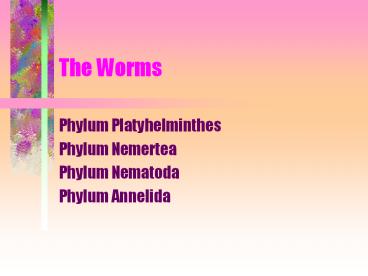The Worms - PowerPoint PPT Presentation
1 / 12
Title:
The Worms
Description:
The Worms Phylum Platyhelminthes Phylum Nemertea Phylum Nematoda Phylum Annelida Bilateral Symmetry One way to cut and get 2 identical halves Front (anterior) and ... – PowerPoint PPT presentation
Number of Views:190
Avg rating:3.0/5.0
Title: The Worms
1
The Worms
- Phylum Platyhelminthes
- Phylum Nemertea
- Phylum Nematoda
- Phylum Annelida
2
Bilateral Symmetry
- One way to cut and get 2 identical halves
- Front (anterior) and rear (posterior)
- Back (dorsal) and belly (ventral)
- More active in pursuit of prey
3
Platyhelminthes - Flatworms
- Dorsoventrally flattened
- Simple Central Nervous system
- Muscular system, Reproductive system - True
organs - Singular opening for gut
4
20,000 Species of Flatworms
- Turbellarians - Free-living carnivores, seen most
in marine habitats - Flukes (Trematodes) largest group, parasites
- Tapeworms (cestodes) live in intestines.
5
Ribbon Worms (Nemertea)
- Sac Gut digestive tract (mouth, gut)
- Circulatory system/Hermaphrodites
- Proboscis used to entangle prey
- Feed on worms and crustaceans
6
Nematodes (some roundworms)
- Live in sediment or tissues of marine organisms
(parasitic) - Cylindrical body, pointed at both ends.
- Larva found in the flesh of many fish
- Infection of humans from eating raw or under
cooked fish
7
(No Transcript)
8
Annelida segmented worms
- Includes earthworms and many marine worms
- Polychaetes marine annelids.
- Each segment has parpodia with setae at the ends.
- Closed circulatory system
- Most carnivores - Nereis
9
More Annelids
- Oligochaetes
- Marine earthworms, found in mud and sand
- Leeches (Hirudinea)
- Most are freshwater sucker at ends
10
Tube worm
Beard Worm
Arrow Worm
11
Brachiopoda (not a worm)
- Lamp shell
- Two valves, dorsal and ventral
- Lophophore, unique feeding structure like two
ciliated, coiled arms
12
The Christmas Tree Worm
The Christmas tree worm, Spirobranchus giganteus,
is a Christmas tree-shaped serpulid tube-dwelling
worm with magnificent twin spirals of plumes used
for feeding and respiration. This cone-shaped
worm is one of the most widely recognized
sedentary polychaete worms.































